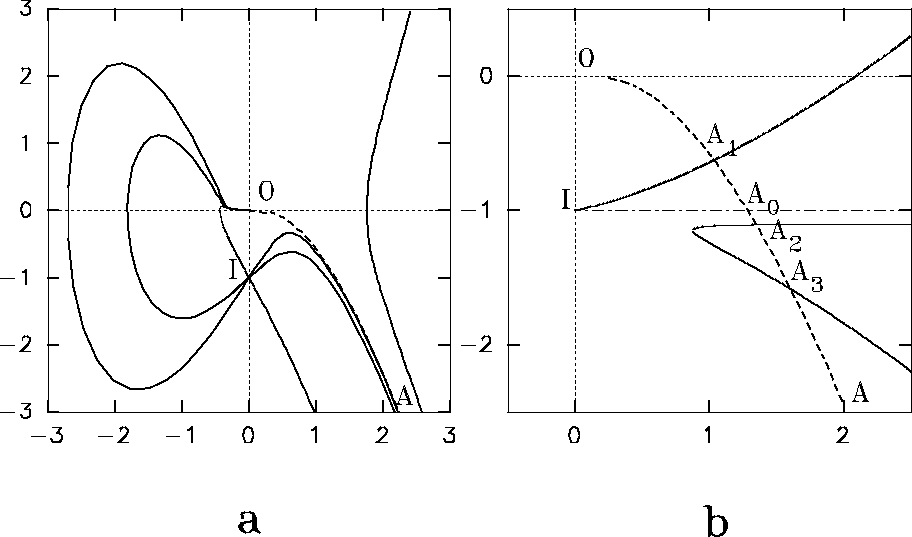A stationary spiral wave rotates rigidly around a fixed point, and its tip describes a circle, called the core of the spiral, centered at that point. The rigid rotation means that the shape of the wave remains constant and only its position on the plane changes, so K and G do not depend on t. In this case, the wave evolution equation (1) can be transformed to an integro-differential one [10, 11],
where ![]() is now the constant angular velocity of the whole
spiral; for definiteness we consider only spirals rotating
counter-clockwise, so that increasing s means moving from left to
right with respect to propagation direction, and
is now the constant angular velocity of the whole
spiral; for definiteness we consider only spirals rotating
counter-clockwise, so that increasing s means moving from left to
right with respect to propagation direction, and ![]() .
.
The boundary conditions of (38) at s=0 are (37), and at infinity
Make a change of variables,
We are interested in solutions with K, and hence y, small. Transformation of equation (38) to an ODE and substitution (40) lead to the following equation:
where prime ' denotes differentiation by the new independent
variable ![]() , with boundary conditions
, with boundary conditions
This poses a nonlinear eigenvalue problem for eigenvalue ![]() and
function
and
function ![]() . Here the dimensionless medium parameters are
defined as
. Here the dimensionless medium parameters are
defined as

Figure 2:
a Phase portrait of equation (41) in coordinates
![]() . O is a complex equilibrium, I
is a non-equilibrium singular point. Dashed line OA is the separatrix
of the origin.
b The boundary-value problem in the same coordinates.
The separatrix OA (dashed) is the only integral curve, obeying
(43); conditions (42) select points on
it, corresponding to the tip. Dash-dotted line IA
. O is a complex equilibrium, I
is a non-equilibrium singular point. Dashed line OA is the separatrix
of the origin.
b The boundary-value problem in the same coordinates.
The separatrix OA (dashed) is the only integral curve, obeying
(43); conditions (42) select points on
it, corresponding to the tip. Dash-dotted line IA ![]() corresponds to
(2,3) and gives the only
intersection point A
corresponds to
(2,3) and gives the only
intersection point A ![]() . Solid lines correspond to
. Solid lines correspond to ![]() ,
,
![]() ,
, ![]() ,
, ![]() ,
, ![]() ,
, ![]() . In this
case, there are three intersections, A, and thus three
solutions,
. In this
case, there are three intersections, A, and thus three
solutions, ![]() , -0.64050, -0.49185,
and
, -0.64050, -0.49185,
and ![]() , 2.2233, 0.12060.
, 2.2233, 0.12060.
A phase portrait of the differential equation (41) without the term
![]() is shown on Fig. 2a. The only integral curve
obeying the condition at infinity (43) is the separatrix OA. This
curve can be described analytically; it is convenient to do that in a
piecewise manner,
is shown on Fig. 2a. The only integral curve
obeying the condition at infinity (43) is the separatrix OA. This
curve can be described analytically; it is convenient to do that in a
piecewise manner,
for ![]() , and
, and
for ![]() , where
, where ![]() is an integration constant
related to the position of the tip point on the separatrix OA. We
will call these pieces the J-branch and the I-branch
respectively (it is easy to see that one is the analytical continuation
of the other).
is an integration constant
related to the position of the tip point on the separatrix OA. We
will call these pieces the J-branch and the I-branch
respectively (it is easy to see that one is the analytical continuation
of the other).
The tip point ( ![]() ) may be at the J-branch if
) may be at the J-branch if
![]() or at the I-branch if
or at the I-branch if ![]() , in the latter
case only the I-branch plays a rôle. Boundary conditions at
the tip from (42) in these two cases are
, in the latter
case only the I-branch plays a rôle. Boundary conditions at
the tip from (42) in these two cases are
where the upper sign is for J-branch and lower sign is for I-branch,
and ![]() is the corresponding function from (45)
or from (46).
is the corresponding function from (45)
or from (46).
So (47) is a system of finite (non-differential) equations for
unknown variables ![]() and
and ![]() , which, in principle, solves the
problem. All kinematical parameters of the spiral wave are expressed
via
, which, in principle, solves the
problem. All kinematical parameters of the spiral wave are expressed
via ![]() and
and ![]() :
:
Here ![]() is the core radius and
is the core radius and ![]() is the orientation angle of
the tip with respect to its radius-vector.
is the orientation angle of
the tip with respect to its radius-vector.
System (47) in its general form is, however, rather complicated:
Fig. 2b illustrates these difficulties: it shows an example with three solutions, while two of them have y(0) small.
In following subsections, we consider two most important special cases, where explicit results can be obtained.